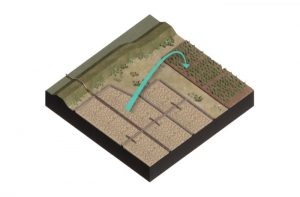Biological ripening
Biological ripening encompasses the effect of all kinds of soil flora and fauna, including larger and microscopic forms of life, but excluding direct activity of humans (Pons & Zonneveld, 1965). The main agents of biological ripening are microorganisms, worms and vegetation.
Microorganisms in the form of aerobic bacteria develop in the earliest stage of ripening, but when matrix pressures lower, fungi become more apparent too (Parr, Gardner, & Elliot, 1981). Microbial activity is fostered by physical ripening to some extent, because cracks provide the aeration of soil. However, it can also inhibit activity because evaporation can make the soil too dry. In terms of matric pressure, optimal activity is around 250kPa, while activity ceases around – 16000kPa (Groenendijk, Kroes, & Rijtema, 1999). The main function of microorganisms in the biological ripening process is to degrade soil organic carbon into humus, which is faster during aerobic conditions compared with anaerobic conditions (Groenendijk et al., 1999). Besides, microorganisms affect many of the biological macro-elemental cycles such as the nitrogen cycle and sulfur cycle. In that respect, microorganisms contribute to chemical ripening as well. Despite the oxygen conditions (aerobic/anaerobic) microorganisms continue to be active and can thereby affect the system drastically. For example, in sulfate rich sediments anaerobic bacteria can transform sulfate into the toxic hydrogen sulfide (H2S), which will inhibit activities of other microbial processes.
Worms can be allocated to soils by birds bringing cocoons attached to their claws or by horizontal dispersion (4-10m per year) (Bal, 1982). Worms prefer moist conditions but can also crack dry soils with tensile stresses; can stay in anoxic environments and can therefore contribute early on but also later in the consolidation and ripening process. Certain species like Tubifex tubifex can withstand extreme conditions and still contribute significantly to dewatering and ripening of oil sand tailings (Yang et al., 2016). Worms can help dewater soils and unconsolidated sediment by tunneling. The tunnels are main pathways for the water to flow through forced by overburden pressure or evaporation. They also consume soil organic matter. Worms are therefore essential for the ripening process, also in terms of amount of soil: they rework 5-120 tons of soil per hectare (Bal, 1982).
Biological ripening by plants encompasses dewatering and mixing the soil particles (Pons & Zonneveld, 1965). Dewatering induces crack formation which induces more aeration of the soil and more dewatering by evaporation. In addition, some vascular wetland plants provide oxygen to the soil via transport of oxygen to the root system and its surroundings (the rhizosphere) (Trapp & Karlson, 2001).

